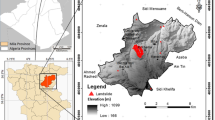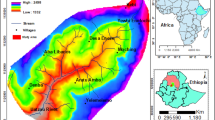Abstract
Landslides have had a huge effect on human life, the environment and local economic development, and therefore they need to be well understood. In this study, we presented an approach for the analysis and modeling of landslide data using rare events logistic regression and applied the approach to an area in Lianyungang, China. Digital orthophotomaps, digital elevation models of the region, geological maps and different GIS layers including settlement, road net and rivers were collected and applied in the analysis. Landslides were identified by monoscopic manual interpretation and validated during the field investigation. To validate the quality of mapping, the data from the study area were divided into a training set and validation set. The result map showed that 4.26% of the study area was identified as having very high susceptibility to landslides, whereas the others were classified as having very low susceptibility (47.2%), low susceptibility (22.21%), medium susceptibility (14.39%) and high susceptibility (11.93%). The quality of the landslide-susceptibility map produced in this paper was validated, and it can be used for planning protective and mitigation measures. The landslide-susceptibility map is a fundamental part of the Lianyungang city landslide risk assessment.










Similar content being viewed by others
References
Akgun A, Bulut F (2007) GIS-based landslide susceptibility for Arsin-Yomra (Trabzon, North Turkey) region. Environ Geol 51:1377–1387
Aleotti P, Chowdhury R (1999) Landslide hazard assessment: summary review and new perspectives. Bull Eng Geol Environ 58:21–44
Allison PD (2001) Logistic regression using the SAS system: theory and application. Wiley Interscience, New York, p 288
Atkinson PM, Massari R (1998) Generalized linear modeling of susceptibility to landsliding in the central Apennines, Italy. Comput Geosci 24:373–385
Ayalew L, Yamagishi H, Marui H, Kanno T (2005) Landslides in Sado Island of Japan Part II. GIS-based susceptibility mapping with comparisons of results from two methods and verifications. Eng Geol 81:432–445
Bai SB, Wang J, Lü GN, Zhou PG, Hou SS, Xu SN (2009) GIS-based and data-driven bivariate landslide-susceptibility mapping in the Three Gorges area, China. Pedosphere 19(1):14–20
Bai SB, Wang J, Lü GN, Zhou PG, Hou SS, Xu SN (2010) GIS-based logistic regression for landslide susceptibility mapping of the Zhongxian segment in the Three Gorges area, China. Geomorphology 115:23–31
Bell R, Glade T (2004) Quantitative risk analysis for landslides—examples from Bdudalur, NW-Iceland. Nat Hazard Earth Syst Sci 4(1):117–131
Can T, Nefeslioglu HA, Gokceoglu C, Sonmez H, Duman TY (2005) Susceptibility assessments of shallow earthflows triggered by heavy rainfall at three subcatchments by logistic regression analyses. Geomorphology 72:250–271
Chang K-T, Chiang S-H, Hsu M-L (2007) Modeling typhoon- and earthquake-induced landslides in a mountainous watershed using logistic regression. Geomorphology 89:335–347
Chung CF, Kojima H, Fabbri AG (2002) Stability analysis of prediction models for landslide hazard mapping. In: Allison RJ (ed) Applied geomorphology: theory and practice. Wiley, London, pp 1–19
Cruden DM, Varnes DJ (1996) Landslide types and processes. In: Turner AK, Shuster RL (eds) Landslides: investigation and mitigation. Transp Res Board, Special Report 247, pp 36–75
Dai FC, Lee CF (2002) Landslide characteristics and slope instability modeling using GIS Lantau Island, Hong Kong. Geomorphology 42:213–238
Dai FC, Lee CF, Li J, Xu ZW (2001) Assessment of landslide susceptibility on the natural terrain of Lantau Island, Hong Kong. Environ Geol 40:381–391
Domínguez-Cuesta MJ, Jiménez-Sánchez M, Berrezueta E (2007) Landslides in the central coalfield (Cantabrian Mountains, NW Spain): geomorphological features, conditioning factors and methodological implications in susceptibility assessment. Geomorphology 89:358–369
Duman TY, Can T, Gokceoglu C, Nefeslioglu HA, Sonmez H (2006) Application of logistic regression for landslide susceptibility zoning of Cekmece Area, Istanbul, Turkey. Environ Geol 51:241–256
García-Rodríguez MJ, Malpica JA, Benito B, Díaz M (2008) Susceptibility assessment of earthquake-triggered landslides in El Salvador using logistic regression. Geomorphology 95:172–191
Glade T (2005) Linking debris-flow hazard assessments with geomorphology. Geomorphology 66:189–213
Greco R, Sorriso-Valvo M, Catalano E (2006) Logistic regression analysis in the evaluation of mass movements susceptibility: the Aspromonte case study, Calabria, Italy. Eng Geol 89:47–66
Guzzetti F, Carrara A, Cardinali M, Reichenbach P (1999) Landslide hazard evaluation: a review of current techniques and their application in a multi-scale study, central Italy. Geomorphology 31:181–216
Guzzetti P, Reichenbach M, Cardinali M, Ardizzone GalliF (2005) Landslide hazard assessment in the Staffora basin, northern Italian Apennines. Geomorphology 72:272–299
Hosmer DW, Lemeshow S (1989) Applied Regression Analysis. Wiley, New York, p 307
Imai K, King G, Lau OK (2005) Zelig: everyone’s statistical software, Version 2.1-3, User’s manual. 197 pp. (http://gking.harvard.edu/zelig/docs/zelig.pdf)
Keefer DK (1984) Landslides caused by earthquakes. Bull Geol Soc Am 95:406–421
King G, Zeng L (2001) Logistic regression in rare events data. Political Anal 9:37–163
Lee S, Min K (2001) Statistical analysis of landslide susceptibility at Yongin, Korea. Environ Geol 40:1095–1113
Menard SW (1995) Applied logistic regression analysis. SAGE Publication, Inc, Thousand Oaks
Moore ID, Burch GJ (1986) Sediment transport capacity of sheet and rill flow: application of unit stream power theory. Water Resour Res 22:1350–1360
Moore ID, Grayson RB, Ladson AR (1991) Digital terrain modeling: a review of hydrological, geomorphological, and biological applications. Hydrol Process 5:3–30
Nefeslioglu HA, Gokceoglu C, Sonmez H (2008) An assessment on the use of logistic regression and artificial neural networks with different sampling strategies for the preparation of landslide susceptibility maps. Eng Geol 97:171–191
Ohlmacher CG, Davis CJ (2003) Using multiple regression and GIS technology to predict landslide hazard in northeast Kansas, USA. Eng Geol 69:331–343
Soeters R, van Westen CJ (1996) Slope instability recognition analysis and zonation. In: Turner KT, Schuster RL (eds) Landslides: investigation and mitigation. Transportation Research Board National Research Council, Special Report, Washington, DC, pp 129–177
Süzen ML, Doyuran V (2004a) Data driven bivariate landslide susceptibility assessment using Geographical Information Systems: a method and application to Asarsuyu catchment, Turkey. Eng Geol 71:303–321
Süzen ML, Doyuran V (2004b) A Comparison of the GIS based landslide susceptibility assessment methods: multivariate versus bivariate. Environ Geol 45:665–679
Van Den Eeckhaut M, Vanwalleghem T, Poesen J, Govers G, Verstraeten G, Vandekerckhove L (2006) Prediction of landslide susceptibility using rare events logistic regression: a case-study in the Flemish Ardennes (Belgium). Geomorphology 76:392–410
Van Westen CJ, Lulie Getahun F (2003) Analyzing the evolution of the Tessina landslide using aerial photographs and digital elevation models. Geomorphology 54:77–89
Van Westen CJ, Castellanos Enrique, Kuriakose SekharL (2008) Spatial data for landslide susceptibility, hazard, and vulnerability assessment: an overview. Eng Geol 102:112–131
Varnes DJ (1978) Slope movement types and processes. In: Schuster RL, Krizek RJ (eds) Landslides, analysis and control. Transportation Research Board Sp. Rep. No. 176, National Academy of Sciences, Philadelphia, pp 11–33
Yesilnacar E, Topal T (2005) Landslide susceptibility mapping: a comparison of logistic regression and neural networks methods in a medium scale study, Hendek region (Turkey). Eng Geol 79:251–266
Acknowledgments
This study was supported by the National Natural Science Foundation of China (nos. 40801212 and 40871010), the National Natural Science Foundation of China (Key Project) (no. 40730527), the National Key Basic Research Program of the early special issues (no. 2007CB416602) and the Opening Fund of State Key Laboratory of Geohazard Prevention and Geoenvironment Protection of Chendu University of Technology, China (no. GZ2007-11).
Author information
Authors and Affiliations
Corresponding author
Rights and permissions
About this article
Cite this article
Bai, S., Lü, G., Wang, J. et al. GIS-based rare events logistic regression for landslide-susceptibility mapping of Lianyungang, China. Environ Earth Sci 62, 139–149 (2011). https://doi.org/10.1007/s12665-010-0509-3
Received:
Accepted:
Published:
Issue Date:
DOI: https://doi.org/10.1007/s12665-010-0509-3




